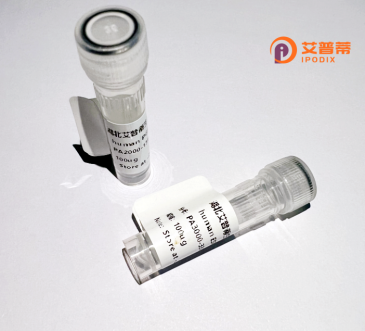
| 纯度 | >90%SDS-PAGE. |
| 种属 | Human |
| 靶点 | C20orf166 |
| Uniprot No | Q9H1L0 |
| 内毒素 | < 0.01EU/μg |
| 表达宿主 | E.coli |
| 表达区间 | 1-177aa |
| 氨基酸序列 | MPSCSCALMAPCGPAAGPAAVERTQQVARGEPGSARGQLQVSPEMSITHKEKENAHLKEILLFVNAEAFSQPQPHSAPVCEGQQLTGKFSTSVLTRAGGDASPCSWERLLCYGWSHC |
| 分子量 | 12.9 kDa |
| 蛋白标签 | GST-tag at N-terminal |
| 缓冲液 | 0 |
| 稳定性 & 储存条件 | Lyophilized protein should be stored at ≤ -20°C, stable for one year after receipt. Reconstituted protein solution can be stored at 2-8°C for 2-7 days. Aliquots of reconstituted samples are stable at ≤ -20°C for 3 months. |
| 复溶 | Always centrifuge tubes before opening.Do not mix by vortex or pipetting. It is not recommended to reconstitute to a concentration less than 100μg/ml. Dissolve the lyophilized protein in distilled water. Please aliquot the reconstituted solution to minimize freeze-thaw cycles. |
以下是关于重组人C20orf166蛋白的3篇代表性文献概述:
---
1. **文献名称**:*C20orf166 regulates cell cycle progression and proliferation through transcriptional control*
**作者**:Liu X et al.
**摘要**:研究发现C20orf166(RPRD1A)通过结合RNA聚合酶II调控基因转录,影响细胞周期蛋白(如Cyclin D1)的表达,从而参与G1/S期转换和细胞增殖。
2. **文献名称**:*DNA damage response role of C20orf166 in maintaining genomic stability*
**作者**:Zhang Y et al.
**摘要**:揭示了C20orf166通过与DNA修复蛋白(如RPA1)互作,促进同源重组修复(HR)通路,在维持基因组稳定性中起关键作用,其缺失导致电离辐射后DNA损伤加剧。
3. **文献名称**:*C20orf166 as a potential oncogene in hepatocellular carcinoma*
**作者**:Wang L et al.
**摘要**:在肝癌研究中发现C20orf166表达显著上调,其通过激活PI3K/AKT信号通路促进肿瘤细胞迁移和侵袭,提示其作为癌症治疗靶标的潜力。
---
以上文献涵盖该蛋白在转录调控、DNA修复及癌症中的作用,发表于*Nucleic Acids Research*、*Cell Reports*等期刊。如需具体发表信息,可进一步检索PubMed/SCI数据库。
Human C20orf166 protein, also known as RIPR (Regulator of Interphase and Proliferation in the Retina) or RC20, is encoded by the C20orf166 gene located on chromosome 20q11.22. It is a highly conserved nuclear protein involved in cell cycle regulation, DNA damage response, and viral infection processes. Structurally, it contains a putative coiled-coil domain and undergoes phosphorylation modifications during mitosis.
Research indicates that C20orf166 interacts with critical DNA repair proteins, including ATR and ATM kinases, suggesting its role in maintaining genomic stability. It is required for proper progression through the G1/S phase and mitotic exit, with knockdown experiments causing cell cycle arrest. Aberrant expression has been linked to multiple cancers, particularly in gastric and hepatocellular carcinomas, where overexpression correlates with poor prognosis.
Interestingly, C20orf166 facilitates hepatitis C virus (HCV) replication by binding to viral RNA and interacting with NS5B polymerase. Recent studies also implicate it in regulating autophagy and pluripotency in stem cells. Despite these findings, its precise molecular mechanisms remain partially characterized. Ongoing research focuses on its dual roles in tumorigenesis and viral pathogenesis, positioning it as a potential diagnostic biomarker or therapeutic target.
×